|
|
You are not currently logged in. Are you accessing the unsecure (http) portal? Click here to switch to the secure portal. |
Difference between revisions of "Monomachia ovvero Arte di Scherma (MS II.iii.315)"
Jump to navigation
Jump to search
| (9 intermediate revisions by 2 users not shown) | |||
| Line 2: | Line 2: | ||
<!----------Name----------> | <!----------Name----------> | ||
| name = [[name::Monomachia ovvero Arte di Scherma]] | | name = [[name::Monomachia ovvero Arte di Scherma]] | ||
| − | | location = [[inventory::MS | + | | location = [[inventory::MS Ⅱ.ⅲ.315]], [[museum::Biblioteca Nazionale Centrale di Firenze]]<br/>Florence, Italy |
<!----------Image----------> | <!----------Image----------> | ||
| − | | image = File:MS II.iii.315 Ir.jpg | + | | image = File:MS II.iii.315 Ir.jpg{{!}}border |
| width = | | width = | ||
| − | | caption = Folio | + | | caption = Folio Ⅰr |
<!----------General----------> | <!----------General----------> | ||
| − | | | + | | Hagedorn's catalog = — |
| − | | Wierschin's catalog = | + | | Wierschin's catalog = — |
| − | | Hils' catalog = | + | | Hils' catalog = — |
| − | | Beck catalog = | + | | Beck catalog = — |
| Also known as = | | Also known as = | ||
| Type = [[type::Fencing manual]] | | Type = [[type::Fencing manual]] | ||
| Line 39: | Line 39: | ||
| below = | | below = | ||
}} | }} | ||
| − | '''''Monomachia ovvero Arte di Scherma''''' ("Dueling, or the Art of Defense", MS | + | '''''Monomachia ovvero Arte di Scherma''''' ("Dueling, or the Art of Defense", MS Ⅱ.ⅲ.315) is a 16th century [[nationality::Italian]] [[fencing manual]] written between 1539 and 1569<ref>Based on its dedication to Cosimo Ⅰ de' Medici as Duke of Florence; after 1569, he was Grand Duke of Tuscany.</ref> by [[Francesco di Sandro Altoni]]. It resides in the holdings of the [[Biblioteca Nazionale Centrale di Firenze]] in Florence, Italy. This is one of two manuscript copies of Altoni's work, the other being the [[Monomachia ovvero Arte di Scherma (MS L.V.23)|MS Ⅼ.Ⅴ.23]]. |
== Provenance == | == Provenance == | ||
| Line 48: | Line 48: | ||
| − | |||
| − | |||
| − | |||
| − | |||
| − | |||
| − | |||
| − | |||
| − | |||
| − | |||
| − | |||
| − | |||
| − | |||
| − | |||
| − | |||
| − | |||
| − | |||
| − | |||
| − | |||
| − | |||
| − | |||
| − | |||
| − | |||
| − | |||
| − | |||
| − | |||
| − | |||
| − | |||
| − | |||
| − | |||
| − | |||
| − | |||
| − | |||
| − | |||
| − | |||
| − | |||
| − | |||
| − | |||
== Gallery == | == Gallery == | ||
| Line 92: | Line 55: | ||
== Additional Resources == | == Additional Resources == | ||
| − | + | {{bibliography}} | |
== References == | == References == | ||
Latest revision as of 19:49, 27 October 2023
| Monomachia ovvero Arte di Scherma | |||||
|---|---|---|---|---|---|
| MS Ⅱ.ⅲ.315, Biblioteca Nazionale Centrale di Firenze Florence, Italy | |||||
 Folio Ⅰr | |||||
| |||||
| |||||
| Type | Fencing manual | ||||
| Date | between 1539 and 1569 | ||||
| Language(s) | Italian | ||||
| Author(s) | Francesco di Sandro Altoni | ||||
| Size | 72 folia | ||||
| Format | Double-sided | ||||
| Treatise scans | Microfilm scans | ||||
Monomachia ovvero Arte di Scherma ("Dueling, or the Art of Defense", MS Ⅱ.ⅲ.315) is a 16th century Italian fencing manual written between 1539 and 1569[1] by Francesco di Sandro Altoni. It resides in the holdings of the Biblioteca Nazionale Centrale di Firenze in Florence, Italy. This is one of two manuscript copies of Altoni's work, the other being the MS Ⅼ.Ⅴ.23.
Contents
Provenance
Contents
Gallery
[Microfilm images available for import.]
Additional Resources
The following is a list of publications containing scans, transcriptions, and translations relevant to this article, as well as published peer-reviewed research.
- Altoni, Francesco di Sandro (2007). Monomachia - Trattato dell'arte di scherma (ca. 1530). Ed. by Marco Rubboli; Iacopo Venni; Alessandro Battistini. Rome: Il Cerchio Iniziative Editoriali.
References
- ↑ Based on its dedication to Cosimo Ⅰ de' Medici as Duke of Florence; after 1569, he was Grand Duke of Tuscany.
Copyright and License Summary
For further information, including transcription and translation notes, see the discussion page.
| Work | Author(s) | Source | License |
|---|---|---|---|
| Images | Tauman.com | ||
| Transcription | Index:Monomachia ovvero Arte di Scherma (MS II.iii.315) |
